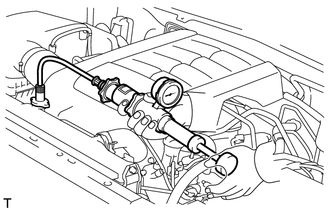On-vehicle Inspection ON-VEHICLE INSPECTION PROCEDURE 1. INSPECT FOR COOLANT LEAK  CAUTION: Do not remove the radiator cap while the engine and radiator are still hot. Pressurized, hot engine coolant and steam may be released and cause serious burns. (a) Fill the radiator with coolant and attach a radiator cap tester. (b) Warm up the engine. (c) Using the radiator cap tester, increase the pressure inside the radiator to 118 kPa (1.2 kgf/cm2, 17 psi), and check that the pressure does not drop. If the pressure drops, check the hoses, radiator and water pump for leaks. If no external leaks are found, check the heater core, cylinder block and head. 2. CHECK ENGINE COOLANT LEVEL IN RESERVOIR
3. CHECK ENGINE COOLANT QUALITY (a) Remove the radiator cap. CAUTION: Do not remove the radiator cap while the engine and radiator are still hot. Pressurized, hot engine coolant and steam may be released and cause serious burns. (b) Check if there are any excessive deposits of rust or scales around the radiator cap and radiator filler hole. Also, the coolant should be free of oil. If excessively dirty, clean the coolant passage and replace the coolant. (c) Install the radiator cap. |
Toyota Tundra Service Manual > Meter / Gauge System: Lost Communication with Cruise Control Front Distance Range Sensor (U0235)
DESCRIPTION The combination meter assembly communicates with the millimeter assembly wave radar sensor assembly via the CAN line. DTC Code DTC Detection Condition Trouble Area U0235 When either of following conditions is detected: IG voltage 10.5 V or more No communication with millimeter assembly w ...